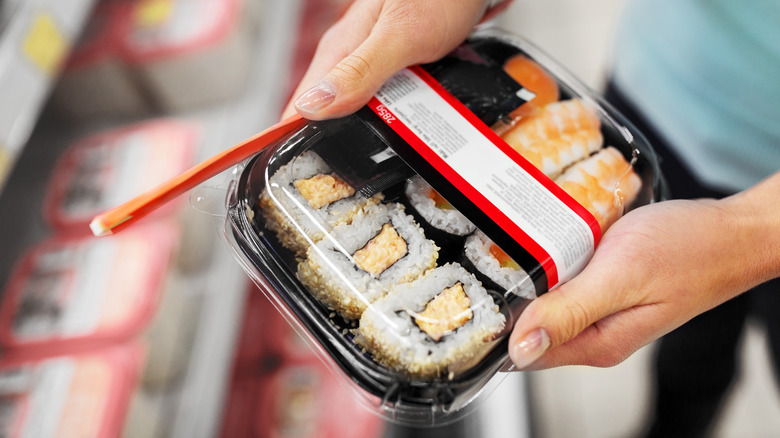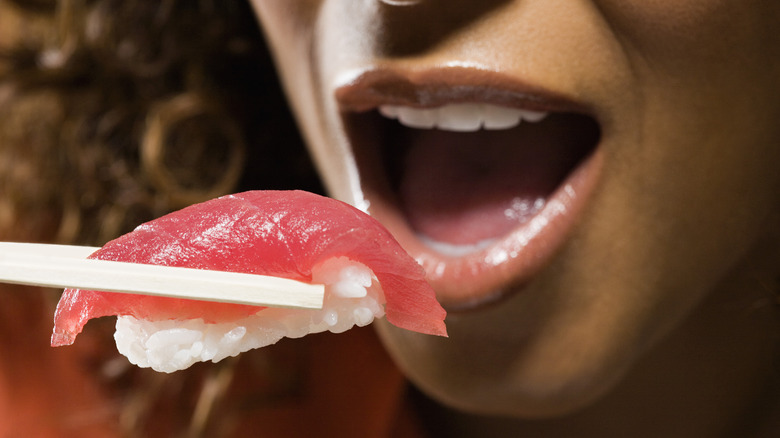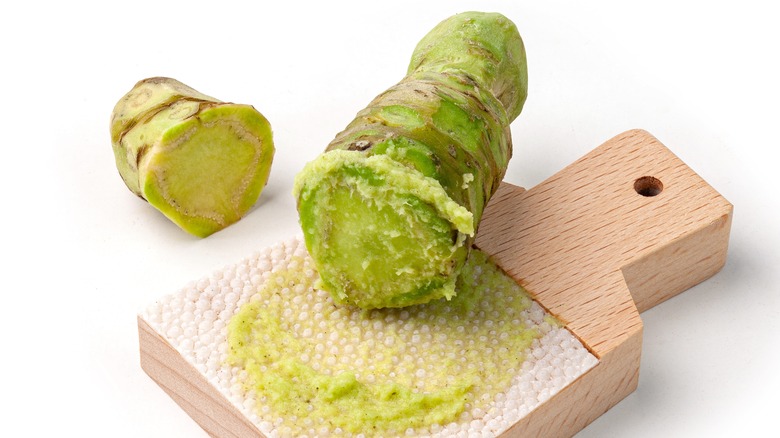Why Grocery Store Sushi Always Tastes A Little Different?
Everyone knows that there is a broad spectrum of acceptability surrounding purchasing certain prepared grocery store foods for munching. For example, snagging one of the famously inexpensive Costco rotisserie chickens, which has remained available for an astonishing $4.99 for almost a decade and a half, is a great option, whether you're considering meal options or planning on crafting a chicken-based dish from the succulent rotisserie meat. On the other hand, making your way to the produce aisle and picking out one of the pre-cut fruit or vegetable platters would be a food quality misstep, as many of the fruits and veggies can lose freshness over time or even pose contamination risks if a neglected product package manages to escape the view of the store employees and overstay its expiration date.
One particular product is the cause of much consternation for grocery store shoppers. When attempting to discern which foods pose considerable contamination risk, you probably instinctively learn about sushi as a high-probability culprit. While eating supermarket sushi is safe, the flavor of the fish is muted when it spends time in the refrigerator. The rice (as well as many other aspects of your sushi eating experience, like the various accouterments included in the package) may have been handled in a manner that results in suboptimal sushi. Furthermore, your grocery store sushi could have been prepared without considering the quality, seasonality, or even the specific species used.
Grocery store sushi fish is less than fresh and possibly fraudulent
There are a number of reasons why the flavor of your local grocery store's sushi may be off. For starters, the sushi has likely been bought from a sizable seafood supplier, meaning that each fish may not have been subjected to the strict quality checks that small sellers use. When a fish is broken down to be sold in the grocery store, it is no longer apparent to the consumer whether or not the fish is fresh. Sushi that has been sliced will begin to oxidize, a process that causes sushi exposed to the air to lose flavor. Furthermore, when sushi is subject to refrigerator temperatures, it will dramatically decrease its flavor.
Arguably, the most important reason why the taste of grocery store sushi is off has to do with the actual fish itself. Studies have revealed that a significant percentage of sushi is mislabeled, meaning the fish you eat may not even be the seafood sold. Another factor in grocery store sushi quality is the species chosen, as grocery stores often opt to use fattier, milder fish. Last but not least, grocery stores don't consider which fish should be available at a given time of year and instead prioritize the convenience of serving popular fish year-round over selling the fish when it's in its optimal stage of life, flavor-wise.
Grocery store sushi uses subpar ingredients
Even when you've moved past consideration of fish freshness, there are still several reasons that grocery store sushi isn't going to taste exactly right. Many of these discrepancies can be attributed to the accouterments surrounding the fish. For many pieces of sushi, particularly the rolls, the first bite that passes between your lips is its kombu sushi wrapping, the general term applied to the seaweed, or kelp, that has been dried out and used to wrap up the rice and fish. Any sushi chef worth their salt will tell you that the seaweed used for sushi rolls should be crispy and dry to provide a textural alternative to the softer stuff inside the roll.
In all likelihood, grocery store sushi wasabi could be the most significant reason your sushi experience tastes so different. Anyone who's sampled sushi is familiar with the spicy green glob. The genuine article is made from a Japanese root herb, but the vast majority of grocery store and restaurant sushi is served with a blend of mustard and horseradish, which are both in the wasabi family. Then, green food dye is used to make the faux blend mimic the expensive herb. However, you should know that your restaurant rolls aren't served with bonafide wasabi either. In fact, 95% of restaurant wasabi is an imposter. The near ubiquity of wasabi's inauthenticity, among other quality considerations, provides context for your grocery store sushi tasting off.


